Long-Term Abandonment of Forest Management Has a Strong Impact on Tree Morphology and Wood Volume Allocation Pattern of European Beech (Fagus sylvatica L.)
Abstract
1. Introduction
2. Materials and Methods
2.1. Study Sites
2.2. TLS Data Acquisition and Registration
2.3. TLS Data Post-Processing
2.4. Statistical Analysis
3. Results
4. Discussion
5. Conclusions
Author Contributions
Funding
Acknowledgments
Conflicts of Interest
Appendix A
| Study Site | SZ | HEV | BKS | SIR |
|---|---|---|---|---|
| Height-diameter ratio | 0.86 | 0.58 | 0.63 | 0.60 |
| a | b | b | b | |
| Mean branch length sum [m] | 1515.6 | 4391.9 | 4072.7 | 4479.9 |
| a | b | b | b | |
| Mean maximum branch order | 8.3 | 9.5 | 9.5 | 9.2 |
| a | b | b | b | |
| Mean branch number 1st order | 44.7 | 39.1 | 44.9 | 53.8 |
| ab | a | ab | b | |
| Mean branch number 2nd order | 274.6 | 389.9 | 407.3 | 559.6 |
| a | b | b | c | |
| Branch volume 1st order [m3] | 638.9 | 1213.0 | 948.1 | 898.6 |
| a | b | ab | ab | |
| Branch volume 2nd order [m3] | 392.4 | 949.0 | 902.3 | 901.9 |
| a | b | b | b | |
| Branch length 1st order [m] | 110.8 | 165.0 | 158.2 | 200.9 |
| a | b | b | c | |
| Branch length 2nd order [m] | 302.1 | 586.9 | 569.5 | 729.1 |
| a | b | b | c | |
| Crown surface area [m2] | 574.9 | 1640.3 | 1437.8 | 1669.9 |
| a | b | b | b | |
| Crown length [m] | 14.7 | 19.3 | 19.2 | 21.4 |
| a | b | b | b | |
| Crown length-width ratio | 2.09 | 1.62 | 1.71 | 1.83 |
| a | b | b | ab | |
| Crown roughness | 0.33 | 0.25 | 0.25 | 0.23 |
| a | b | b | b |
References
- West, G.B.; Brown, J.H.; Enquist, B.J. A general model for the origin of allometric scaling laws in biology. Science 1997, 276, 122–126. [Google Scholar] [CrossRef] [PubMed]
- Valladares, F.; Niinemets, U. The architecture of plant crowns: From design rules to light capture and performance. In Functional Plant Ecology; Pugnaire, F., Valladares, F., Eds.; Taylor and Francis: New York, NY, USA, 2007; pp. 101–149. [Google Scholar]
- Malhi, Y.; Jackson, T.; Patrick Bentley, L.; Lau, A.; Shenkin, A.; Herold, M.; Calders, K.; Bartholomeus, H.; Disney, M.I. New perspectives on the ecology of tree structure and tree communities through terrestrial laser scanning. Interface Focus 2018, 8, 20170052. [Google Scholar] [CrossRef] [PubMed]
- Maas, H.G.; Bienert, A.; Scheller, S.; Keane, E. Automatic forest inventory parameter determination from terrestrial laser scanner data. Int. J. Remote Sens. 2008, 29, 1579–1593. [Google Scholar] [CrossRef]
- Hess, C.; Bienert, A.; Härdtle, W.; von Oheimb, G. Does tree architectural complexity influence the accuracy of wood volume estimates of single young trees by terrestrial laser scanning? Forests 2015, 6, 3847–3867. [Google Scholar] [CrossRef]
- Liang, X.; Kankare, V.; Hyyppä, J.; Wang, Y.; Kukko, A.; Haggrén, H.; Yu, X.; Kaartinen, H.; Jaakkola, A.; Guan, F.; et al. Terrestrial laser scanning in forest inventories. J. Photogramm. Remote Sens. 2016, 115, 63–77. [Google Scholar] [CrossRef]
- Leuschner, C.; Ellenberg, H. Ecology of Central European Forests: Vegetation Ecology of Central Europe; Springer: Berlin, Germany, 2017; Volume I, p. 971. [Google Scholar]
- Bayer, D.; Seifert, S.; Pretzsch, H. Structural crown properties of Norway spruce (Picea abies L. Karst.) and European beech (Fagus sylvatica L.) in mixed versus pure stands revealed by terrestrial laser scanning. Trees 2013, 27, 1035–1047. [Google Scholar] [CrossRef]
- Metz, J.; Seidel, D.; Schall, P.; Scheffer, D.; Schulze, E.D.; Ammer, C. Crown modeling by terrestrial laser scanning as an approach to assess the effect of aboveground intra- and interspecific competition on tree growth. For. Ecol. Manag. 2013, 310, 275–288. [Google Scholar] [CrossRef]
- Barbeito, I.; Dassot, M.; Bayer, D.; Collet, C.; Drössler, L.; Löf, M.; Del Rio, M.; Ruiz-Peinado, R.; Forrester, D.I.; Bravo-Oviedo, A.; et al. Terrestrial laser scanning reveals differences in crown structure of Fagus sylvatica in mixed vs pure European forests. For. Ecol. Manag. 2017, 405, 381–390. [Google Scholar] [CrossRef]
- Höwler, K.; Annighöfer, P.; Ammer, C.; Seidel, D. Competition improves quality-related external stem characteristics of Fagus sylvatica. Can. J. For. Res. 2017, 47, 1603–1613. [Google Scholar] [CrossRef]
- Seidel, D.; Leuschner, C.; Müller, A.; Krause, B. Crown plasticity in mixed forests—Quantifying asymmetry as a measure of competition using terrestrial laser scanning. For. Ecol. Manag. 2011, 261, 2123–2132. [Google Scholar] [CrossRef]
- Dieler, J.; Pretzsch, H. Morphological plasticity of European beech (Fagus sylvatica L.) in pure and mixed-species stands. For. Ecol. Manag. 2013, 295, 97–108. [Google Scholar] [CrossRef]
- Schröter, M.; Härdtle, W.; von Oheimb, G. Crown plasticity and neighborhood interactions of European beech (Fagus sylvatica L.) in an old-growth forest. Eur. J. For. Res. 2012, 131, 787–798. [Google Scholar] [CrossRef]
- Engel, M.; Körner, M.; Berger, U. Plastic tree crowns contribute to small-scale heterogeneity in virgin beech forests—An individual-based modeling approach. Ecol. Model. 2018, 376, 28–39. [Google Scholar] [CrossRef]
- Fichtner, A.; Sturm, K.; Rickert, C.; von Oheimb, G.; Härdtle, W. Crown size-growth relationships of European beech (Fagus sylvatica L.) are driven by the interplay of disturbance intensity and inter-specific competition. For. Ecol. Manag. 2013, 302, 178–184. [Google Scholar] [CrossRef]
- Seidel, D.; Schall, P.; Gille, M.; Ammer, C. Relationship between tree growth and physical dimensions of Fagus sylvatica crowns assessed from terrestrial laser scanning. iForest 2015, 8, 735–742. [Google Scholar] [CrossRef]
- Juchheim, J.; Annighöfer, P.; Ammer, C.; Calders, K.; Raumonen, P.; Seidel, D. How management intensity and neighborhood composition affect the structure of beech (Fagus sylvatica L.) trees. Trees 2017, 31, 1723–1735. [Google Scholar] [CrossRef]
- Mausolf, K.; Wilm, P.; Härdtle, W.; Jansen, K.; Schuldt, B.; Sturm, K.; von Oheimb, G.; Hertel, D.; Leuschner, C.; Fichtner, A. Higher drought sensitivity of radial growth of European beech in managed than in unmanaged forests. Sci. Total Environ. 2018, 642, 1201–1208. [Google Scholar] [CrossRef] [PubMed]
- Petzold, J.; Dittrich, S.; Fichtner, A.; Härdtle, W.; Naumann, B.; von Oheimb, G. Effects of forest management intensity on herbaceous plant diversity and composition of deciduous forest communities in Northern Germany. Tuexenia 2018, 38, 79–96. [Google Scholar] [CrossRef]
- Stiers, M.; Willim, K.; Seidel, D.; Ehbrecht, M.; Kabal, M.; Ammer, C.; Annighöfer, P. A quantitative comparison of the structural complexity of managed, lately unmanaged and primary European beech (Fagus sylvatica L.) forests. For. Ecol. Manag. 2018, 430, 357–365. [Google Scholar] [CrossRef]
- Deutscher Wetterdienst. Klimareport Schleswig-Holstein; Deutscher Wetterdienst: Offenbach am Main, Germany, 2017; p. 44.
- Stadtwald Lübeck. Konzept der Naturnahen Waldwirtschaft und Forstplanung im Stadtwald Lübeck. Ergebnisse aus Waldbiotopkartierung, Forstinventur und Betriebsprüfung; Forstamt der Stadt Lübeck: Lübeck, Germany, 2004.
- Sturm, K. Grundlagen und Ziele des integrativen Prozessschutz-Waldbaus. In Natura 2000 im Wald—Lebensraumtypen, Erhaltungszustand, Management; Lehrke, S., Ellwanger, G., Buschmann, A., Frederking, W., Paulsch, C., Schröder, E., Ssymank, A., Eds.; Landwirtschaftsvlg: Münster, Germany, 2013; Volume 131, pp. 219–232. [Google Scholar]
- Pfennigbauer, M.; Ullrich, A. Improving quality of laser scanning data acquisition through calibrated amplitude and pulse deviation measurement. In Proceedings of the SPIE Defense, Security and Sensing, Orlando, FL, USA, 29 April 2010. [Google Scholar] [CrossRef]
- Riegl RIEGL Product Line–Innovations in 3D. Available online: https://user-539731.cld.bz/RIEGL-Online-Catalog-2017-20182 (accessed on 29 August 2018).
- Pretzsch, H. Forests Dynamics, Growth and Yield; Springer: Berlin, Germany, 2009; p. 664. [Google Scholar]
- Hackenberg, J.; Wassenberg, M.; Spiecker, H.; Sun, D. Non-destructive method for biomass prediction combining TLS derived tree volume and wood density. Forests 2015, 6, 1274–1300. [Google Scholar] [CrossRef]
- Raumonen, P.; Kaasalainen, M.; Åkerblom, M.; Kaasalainen, S.; Kaartinen, H.; Vastaranta, M.; Holopainen, M.; Disney, M.; Lewis, P. Fast automatic precision tree models from terrestrial laser scanner data. Remote Sens. 2013, 5, 491–520. [Google Scholar] [CrossRef]
- Calders, K.; Newnham, G.; Burt, A.; Murphy, S.; Raumonen, P.; Herold, M.; Culvenor, D.; Avitabile, V.; Disney, M.; Armston, J.; et al. Nondestructive estimates of above-ground biomass using terrestrial laser scanning. Methods Ecol. Evol. 2015, 6, 198–208. [Google Scholar] [CrossRef]
- Bienert, A.; Georgi, L.; Kunz, M.; Maas, H.G.; von Oheimb, G. Comparison and combination of mobile and terrestrial laser scanning for natural forest inventories. Forests 2018, 9, 395. [Google Scholar] [CrossRef]
- Raumonen, P.; Casella, E.; Calders, K.; Murphy, S.; Åkerblom, M.; Kaasalainen, M. Massive-scale tree modelling from TlS data. ISPRS Ann. Photogramm. Remote Sens. Spat. Inf. Sci. 2015, II-3/W4, 189–196. [Google Scholar] [CrossRef]
- Kunz, M.; Hess, C.; Raumonen, P.; Bienert, A.; Hackenberg, J.; Maas, H.G.; Härdtle, W.; Fichtner, A.; von Oheimb, G. Comparison of wood volume estimates of young trees from terrestrial laser scan data. iForest 2017, 10, 451–458. [Google Scholar] [CrossRef]
- Rusu, R.B.; Cousins, S. 3D is here: Point cloud library (PCL). In Proceedings of the ‘IEEE International Conference on Robotics and Automation (ICRA), Shanghai, China, 9–13 May 2011. [Google Scholar] [CrossRef]
- Kai, T.; Da, F.; Yvinec, M. 3D Alpha Shapes. Available online: http://www.ics.uci.edu/~dock/manuals/ cgal_manual/Alpha_shapes_3/Chapter_main.html (accessed on 29 August 2018).
- Martin-Ducup, O.; Robert, S.; Fournier, R.A. Response of sugar maple (Acer saccharum, Marsh.) tree crown structure to competition in pure versus mixed stands. For. Ecol. Manag. 2016, 374, 20–32. [Google Scholar] [CrossRef]
- R Core Team. R: A Language and Environment for Statistical Computing; R Foundation for Statistical Computing: Vienna, Austria, 2017. [Google Scholar]
- Lang, A.C.; Härdtle, W.; Bruelheide, H.; Geißler, C.; Nadrowski, K.; Schuldt, A.; von Oheimb, G. Tree morphology responds to neighbourhood competition and slope in species-rich forests of subtropical China. For. Ecol. Manag. 2010, 260, 1708–1715. [Google Scholar] [CrossRef]
- Dassot, M.; Constant, T.; Ningre, F.; Fournier, M. Impact of stand density on tree morphology and growth stress in young beech (Fagus sylvatica L.) stands. Trees 2015, 29, 583–591. [Google Scholar] [CrossRef]
- Von Oheimb, G.; Lang, A.C.; Bruelheide, H.; Forrester, D.I.; Wäsche, I.; Yu, M.; Härdtle, W. Individual-tree radial growth in a subtropical broad-leaved forest: The role of local neighbourhood competition. Forest Ecol. Manag. 2011, 261, 499–507. [Google Scholar] [CrossRef]
- Fichtner, A.; Härdtle, W.; Bruelheide, H.; Kunz, M.; Li, Y.; von Oheimb, G. Neighbourhood interactions drive overyielding in mixed-species tree communities. Nat. Commun. 2018, 9, 1144. [Google Scholar] [CrossRef] [PubMed]
- Pretzsch, H. Canopy space filling and tree crown morphology in mixed-species stands compared with monocultures. For. Ecol. Manag. 2014, 327, 251–264. [Google Scholar] [CrossRef]
- Fichtner, A.; Härdtle, W.; Li, Y.; Bruelheide, H.; Kunz, M.; von Oheimb, G. From competition to facilitation: How tree species respond to neighbourhood diversity. Ecol. Lett. 2017, 20, 892–900. [Google Scholar] [CrossRef] [PubMed]
- Fichtner, A.; Forrester, D.I.; Härdtle, W.; Sturm, K.; von Oheimb, G. Facilitative-competitive interactions in an old-growth forest: The importance of large-diameter trees as benefactors and stimulators for forest community assembly. PLoS ONE 2015, 10, E0120335. [Google Scholar] [CrossRef] [PubMed]
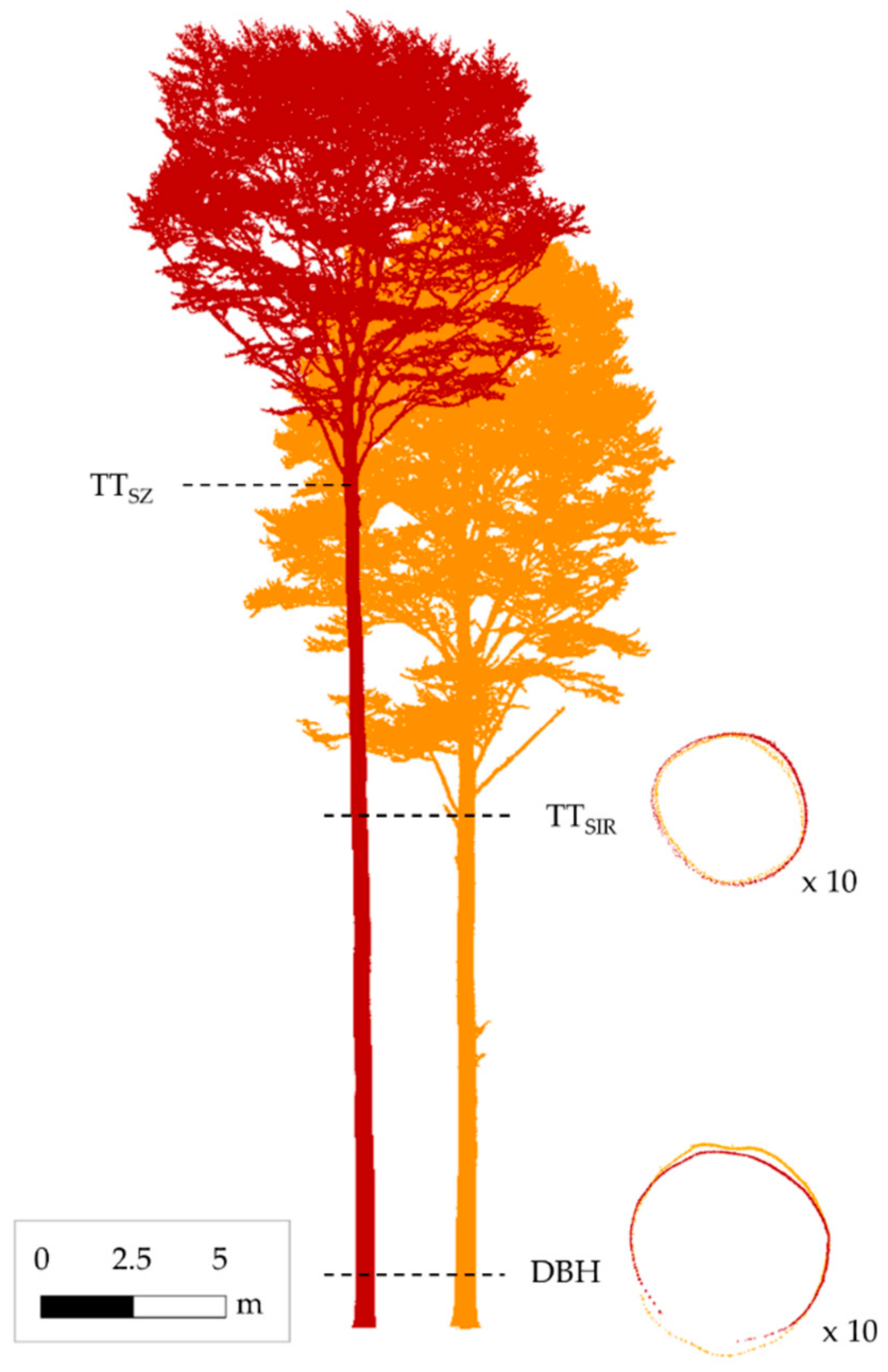
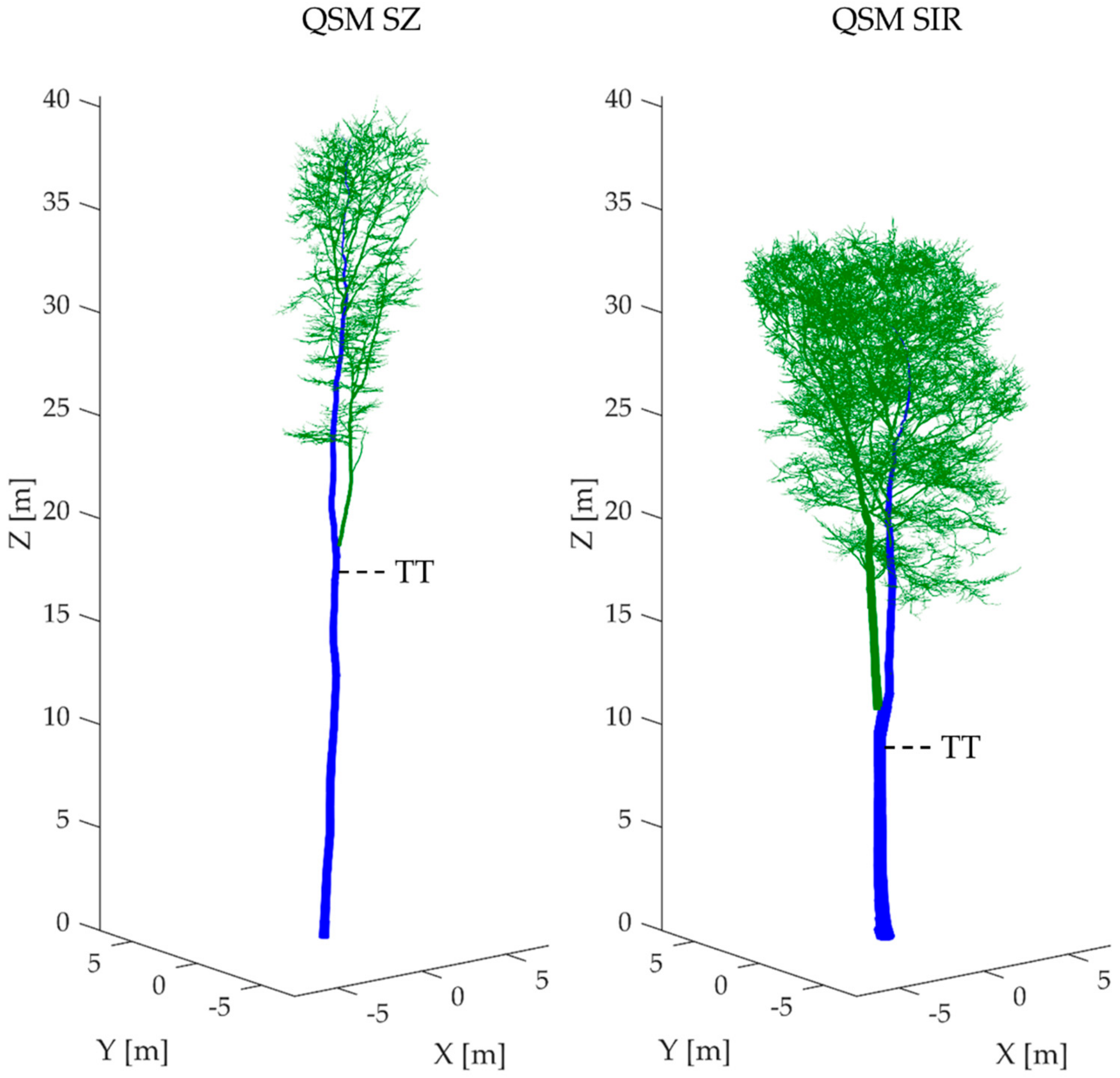
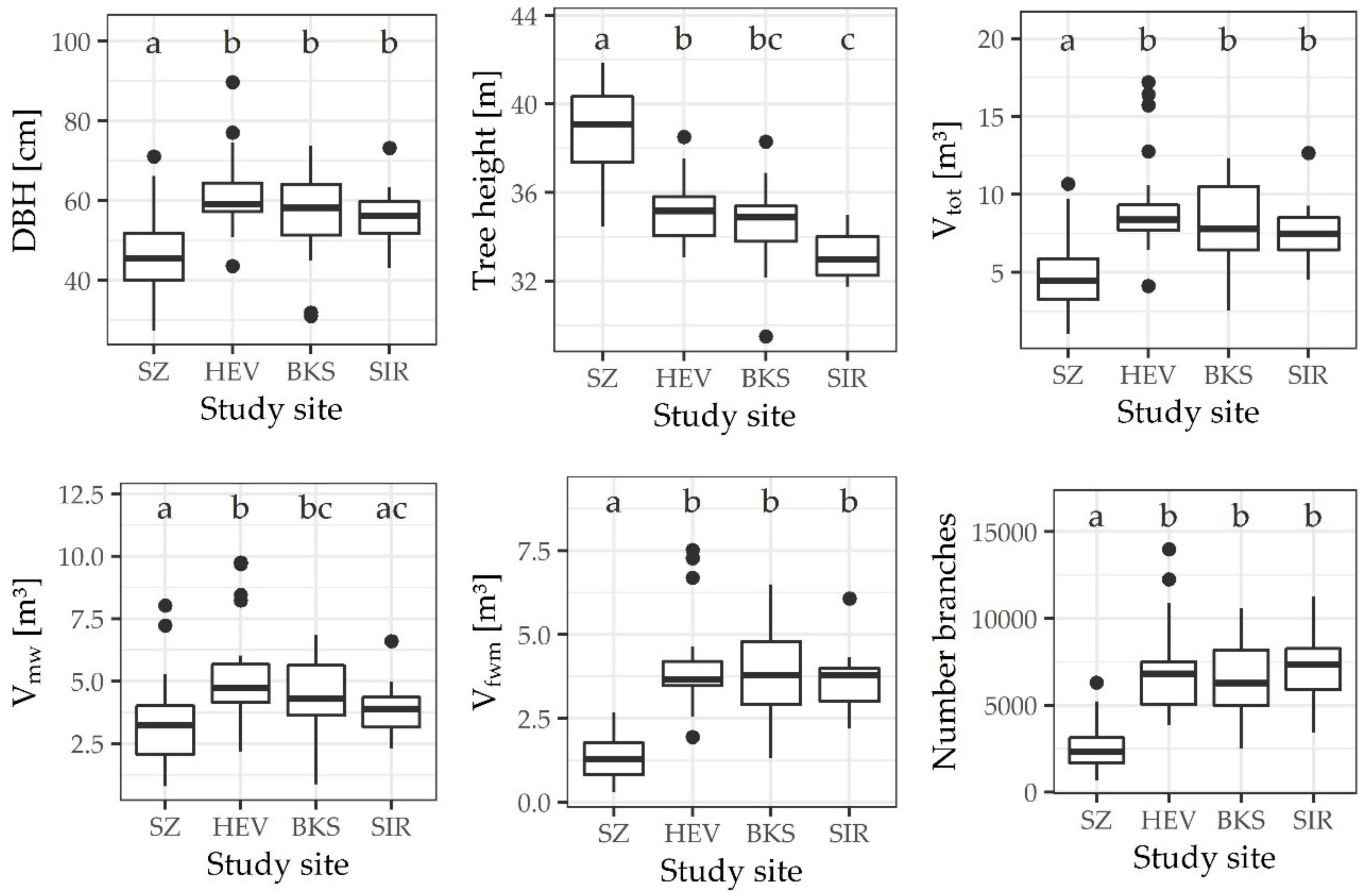
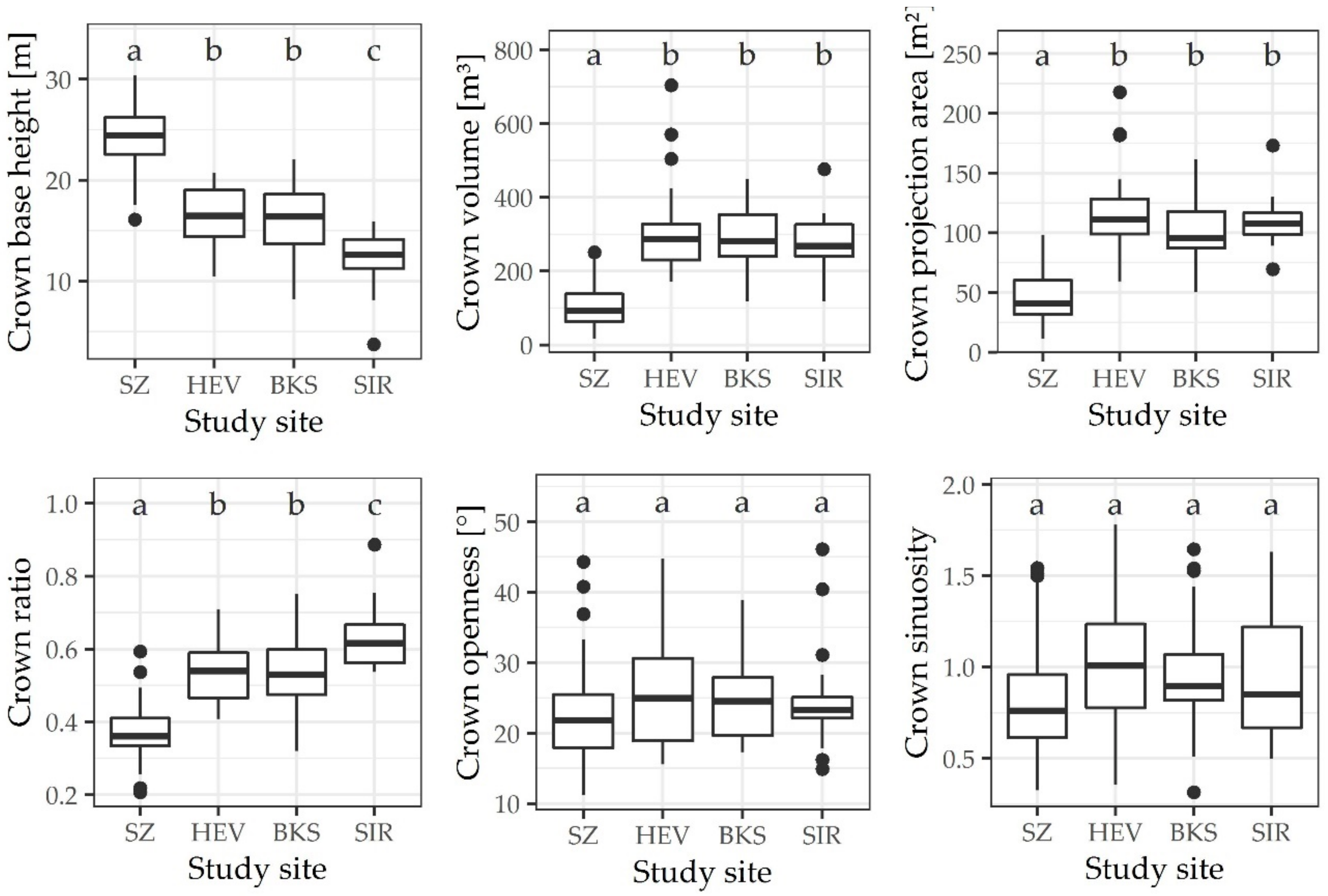


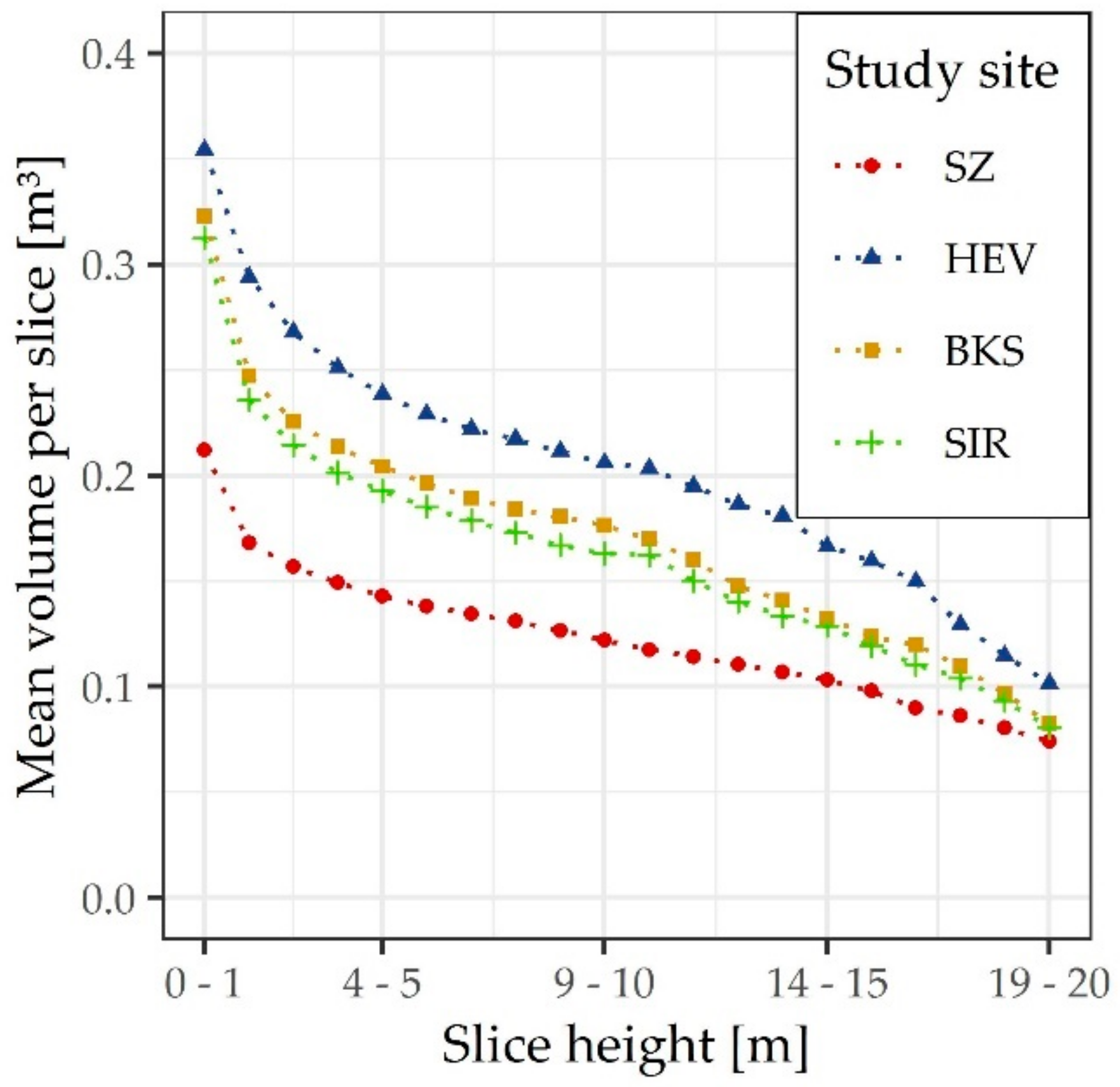
| Schattiner Zuschlag (SZ) | Hevenbruch (HEV) | Berkenstrücken (BKS) | Sirksfelder Zuschlag (SIR) | |
|---|---|---|---|---|
| Management intensity | Unmanaged > 50 years | Unmanaged > 20 years | Extensively managed | Intensively managed |
| Elevation (m a.s.l.) | 58 | 75 | 80 | 65 |
| Soil type | (pseudogleyic) luvisol | (pseudogleyic) luvisol | (pseudogleyic) luvisol | (pseudogleyic) luvisol |
| Age (years) | 109 | 121 | 105 | 110 |
| Stem density (n ha−1) | 369 | 194 | 188 | 104 |
| Stand volume (m3 ha−1) | 903 | 690 | 652 | 392 |
| Stand basal area (m2 ha−1) | 59 | 34 | 39 | 25 |
| Mean diameter at breast height (cm) | 44 | 45 | 47 | 54 |
| Mean tree height (m) | 41 | 36 | 39 | 34 |
| Measure | Abbreviation | Origin | Reference/Calculation |
|---|---|---|---|
| Diameter at breast height (cm) | DBH | QSM | Raumonen et al. (2013) |
| Tree height (m) | TH | Point cloud | Zmax-Zmin |
| Total wood volume (m3) | Vtot | QSM | Raumonen et al. (2013) |
| Total branch number | QSM | Raumonen et al. (2013) | |
| Height-to-diameter ratio | H/D-ratio | Point cloud | TH/DBH 100 |
| Merchantable wood volume (m3) | Vmw | QSM | See Section 2.3. this publication |
| Volume of fine woody material (m3) | Vfwm | QSM | See Section 2.3. this publication |
| Crown base height (m) | CBH | Point cloud | See Section 2.3. this publication |
| Crown volume (m3) | CV | Point cloud | See Section 2.3. this publication |
| Crown projection area (m2) | CPA | Point cloud | See Section 2.3. this publication |
| Crown surface area (m2) | CSA | Point cloud | See Section 2.3. this publication |
| Crown ratio | CR | Point cloud | CL/TH |
| Crown length (m) | CL | Point cloud | TH-CBH |
| Crown openness (°) | Point cloud | Martin-Ducup et al. (2016) | |
| Crown sinuosity | Point cloud | Martin-Ducup et al. (2016) | |
| Taper (cm m−1) | Point cloud | See Section 2.3. this publication | |
| Taper top height (m) | TT | Point cloud | See Section 2.3. this publication |
| Volume of branch-free trunk (m3) | Vbft | QSM | See Section 2.3. this publication |
| Mean branch length sum (m) | QSM | Raumonen et al. (2013) | |
| Mean maximum branch order | QSM | Raumonen et al. (2013) | |
| Mean branch number 1st order | QSM | Raumonen et al. (2013) | |
| Mean branch number 2nd order | QSM | Raumonen et al. (2013) | |
| Branch volume 1st order (m3) | QSM | Raumonen et al. (2013) | |
| Branch volume 2nd order (m3) | QSM | Raumonen et al. (2013) | |
| Branch length 1st order (m) | QSM | Raumonen et al. (2013) | |
| Branch length 2nd order (m) | QSM | Raumonen et al. (2013) | |
| Crown length-width ratio | Point cloud | CL/(sqrt(CPA 4 π−1)) | |
| Crown roughness | Point cloud | Martin-Ducup et al. (2016) |
© 2018 by the authors. Licensee MDPI, Basel, Switzerland. This article is an open access article distributed under the terms and conditions of the Creative Commons Attribution (CC BY) license (http://creativecommons.org/licenses/by/4.0/).
Share and Cite
Georgi, L.; Kunz, M.; Fichtner, A.; Härdtle, W.; Reich, K.F.; Sturm, K.; Welle, T.; Oheimb, G.v. Long-Term Abandonment of Forest Management Has a Strong Impact on Tree Morphology and Wood Volume Allocation Pattern of European Beech (Fagus sylvatica L.). Forests 2018, 9, 704. https://doi.org/10.3390/f9110704
Georgi L, Kunz M, Fichtner A, Härdtle W, Reich KF, Sturm K, Welle T, Oheimb Gv. Long-Term Abandonment of Forest Management Has a Strong Impact on Tree Morphology and Wood Volume Allocation Pattern of European Beech (Fagus sylvatica L.). Forests. 2018; 9(11):704. https://doi.org/10.3390/f9110704
Chicago/Turabian StyleGeorgi, Louis, Matthias Kunz, Andreas Fichtner, Werner Härdtle, Karl Friedrich Reich, Knut Sturm, Torsten Welle, and Goddert von Oheimb. 2018. "Long-Term Abandonment of Forest Management Has a Strong Impact on Tree Morphology and Wood Volume Allocation Pattern of European Beech (Fagus sylvatica L.)" Forests 9, no. 11: 704. https://doi.org/10.3390/f9110704
APA StyleGeorgi, L., Kunz, M., Fichtner, A., Härdtle, W., Reich, K. F., Sturm, K., Welle, T., & Oheimb, G. v. (2018). Long-Term Abandonment of Forest Management Has a Strong Impact on Tree Morphology and Wood Volume Allocation Pattern of European Beech (Fagus sylvatica L.). Forests, 9(11), 704. https://doi.org/10.3390/f9110704





